Areesh
ELITE MEMBER

- Joined
- Mar 30, 2010
- Messages
- 45,157
- Reaction score
- 3
- Country
- Location
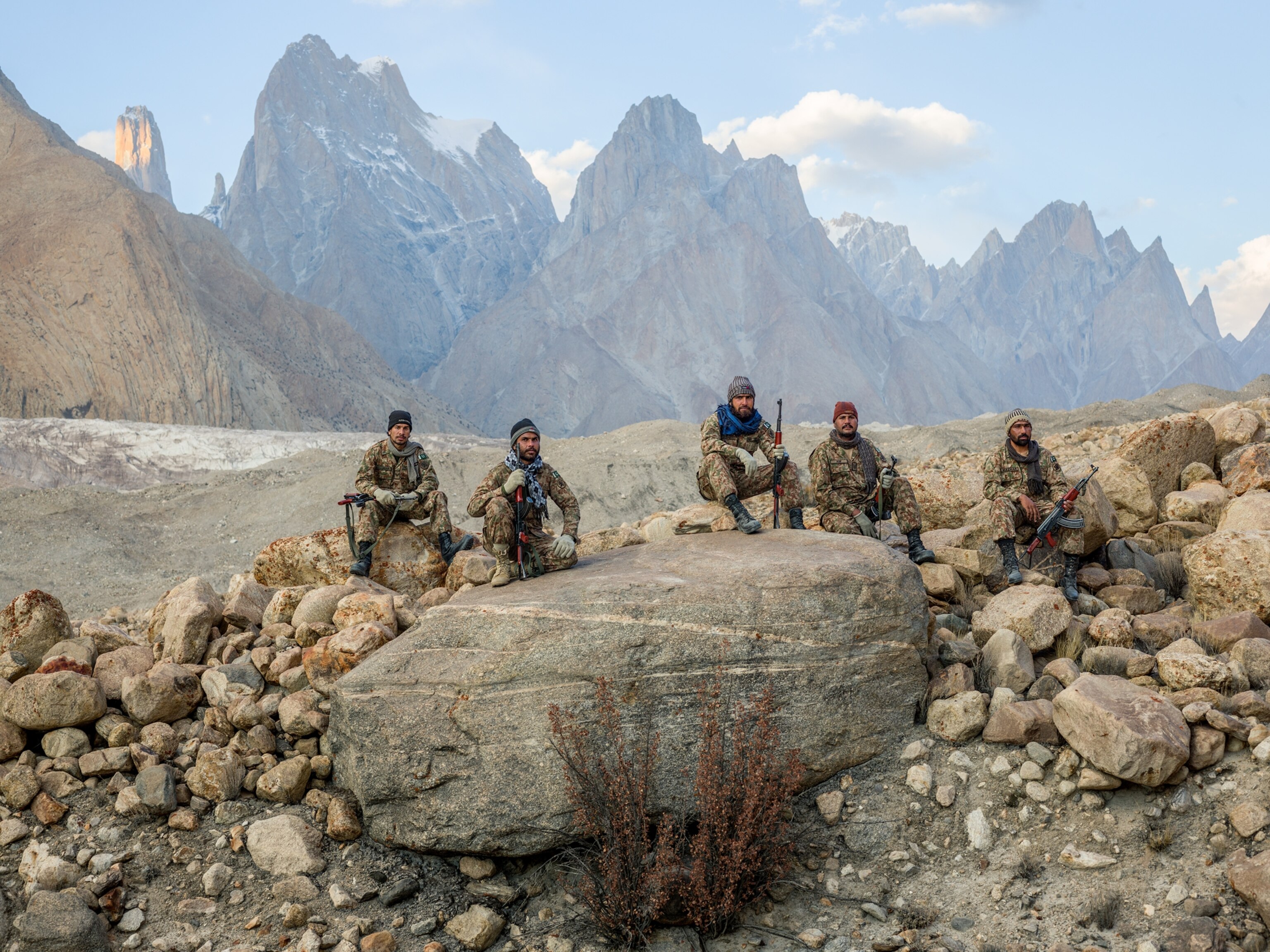
Soldiers assigned to the 62 Brigade of the Pakistan Army pause beneath the Trango Towers at the terminus of the Baltoro Glacier. “It’s difficult terrain,” one says. “But we must defend every inch of our motherland.”
Maj. Abdul Bilal of the Pakistan Army’s Special Service Group huddled with his team beneath a rock outcropping deep in the Karakoram Range. It was April 30, 1989, and a late afternoon snow squall gathered around the 11 men as they labored to breathe the thin air more than four miles above sea level. At first glance they might have appeared to be mountaineers, except for the white camouflage jackets they wore and the automatic weapons slung over their shoulders. In fact, mountaineers would have been jealous of this vantage point, which offered a panorama of some of the world’s most colossal mountains. The hulk of K2, the second highest point on Earth, loomed just over the horizon, 50 miles to the northwest. But the majority of the icy peaks remained unclimbed and nameless, identified on maps only by numbers that corresponded to their elevations.Climbing to their position on this peak, labeled 22,158, would’ve required ascending an avalanche-riddled face of rock and ice. Four men had died trying. Instead, Bilal’s team had been ferried by helicopter. One by one, the men dangled from ropes as the helicopters struggled to stay aloft in the thin, subfreezing atmosphere. Deposited some 1,500 feet below the summit, the team spent a week fixing ropes and reconnoitering the terrain above to prepare for this decisive moment.A few men suggested they rope up for safety. “If you rope up, if one of us is hit, then all of us go down,” Bilal told them. “Wear crampons but no ropes.” They made a final check to make sure the moving parts on their weapons hadn’t frozen. And then, just before dusk, with howling wind at their backs, Bilal led the team single file as they climbed up a corniced ridge toward the summit.

Pakistani soldiers unload an Mi-17 helicopter at the Paiju administrative post. Vital supplies range from drums of aviation fuel to construction rebar to fresh eggs. For troops deployed along both sides of the Saltoro Range, helicopters are a lifeline. “Angels from above,” one officer said.

At the Sarfaranga firing range outside Skardu, Pakistani soldiers clean their G3A3 rifles and snack on bananas during a training session.
Suddenly the dark, sunburned faces of two Indian sentries peered down from a wall of snow built in a makeshift observation post. Bilal called out to them in Urdu, “You are surrounded by soldiers of the Pakistan Army. Lay down your arms.”
The two Indians ducked down behind the snow wall. Bilal continued, “The Indian Army is going to get you killed by sending you here!” Then he heard the distinctive, two-click cadence of AK-47s cocking.
“We weren’t wanton killers,” Bilal says three decades later, recounting the story in his home in Rawalpindi. “We just wanted to preserve our own territory. We would defend it at all costs ... that was our patriotic duty.” He is certain the Indians fired first. Bilal and his men returned fire. The crack of the shots was dampened by the snow and the thin air, and one of the Indians went down.
The Pakistanis stopped firing, and Bilal called to the other Indian. “Leave this place … We’re not going to take you prisoner, and we won’t shoot you in the back.” The Indian soldier stood up, and Bilal watched him trudge away, panting for breath, until he disappeared into the mist.
Few outside of Pakistan and India took notice. And yet the Battle of Peak 22,158 bears a macabre distinction: It’s the highest lethal ground combat ever recorded.
On a bluebird morning 28 years later, photographer Cory Richards and I shuffled awkwardly onto the boot-stomped snow of a helipad a few miles from the spot of that encounter. As professional mountaineers, we both had climbed peaks in the Karakoram and understood the effort and skills required simply to survive here.
For more than three decades, India and Pakistan have sent young soldiers to this harsh environment, where they remain for months at a time, guarding a remote, uninhabited wilderness. Observers began referring to the confrontation as the Siachen Glacier conflict, after the monumental sheet of ice that dominates the landscape where the disputed borders of Pakistan, India, and China meet.
Since 1984, the two sides have incurred thousands of casualties. A cease-fire was agreed to in 2003, but dozens of soldiers still die here each year—from landslides, avalanches, helicopter crashes, altitude sickness, embolisms, and other causes. Nevertheless, every year Indian and Pakistani soldiers eagerly volunteer to serve here. “It’s seen as an extreme badge of honor,” one Pakistani official told me.
Shelves of books, news articles, and scholarly papers have been written about the conflict, with authors often remarking on the absurdity of armies fighting over such useless territory. The general assertion is that two stubborn enemies, blinded by hatred, will go to the most extreme lengths to oppose each other, a notion crystallized by Stephen P. Cohen, an analyst at the Brookings Institution, who famously summed up the Siachen conflict as “a struggle of two bald men over a comb.”
But the circumstances that prompted the two bald men to start fighting have never been fully explained. I’d spent four years following a paper trail of recently declassified documents and interviewing officials, scholars, and military personnel in India, Pakistan, and the United States, trying to unravel an obscure but important mystery to the Siachen saga. And now Cory and I had come to Pakistan to see firsthand the consequences of what can happen from the seemingly simple act of drawing a line on a map.
The Geographer
On June 27, 1968, 21 years before Bilal led his team up Peak 22,158, Airgram A-1245 was sent to the Office of the Geographer, a little-known unit buried within the U.S. State Department’s labyrinthine C Street NW headquarters in Washington, D.C. It eventually landed on the desk of 45-year-old assistant geographer Robert D. Hodgson.
Signed by William Weathersby, the chargé d’affaires in the U.S. Embassy in New Delhi, the letter began: “On various occasions … the Government of India has formally protested to the Embassy about U.S. Government maps which were distributed in India showing the status of Kashmir as ‘in dispute’ or in some way separate from the rest of India.” It closed with a request for guidance on how to represent India’s borders on U.S. maps.
For India and Pakistan, nations born from the bloodshed that accompanied Partition—the official term for the dissolution and subdivision of British India—maps were a matter of national identity. But for Hodgson and the other staff of the Office of the Geographer, they were a professional trade.
Every year the U.S. government published thousands of maps—by many estimates it was the largest map publisher in the world. Responsibility for depicting international political boundaries fell to the Office of the Geographer.
This mission gave the office considerable influence over far-reaching corners of the U.S. government, including the Department of Defense and the CIA. The office held the ultimate authority to depict the alignment of the world’s political borders as far as the official U.S. policy was concerned and, in turn, helped shape the way other nations viewed them. It also meant that, among the approximately 325 country-to-country land boundaries the U.S. recognized, the thorniest cartographic questions fell to Hodgson and his fellow geographers. Addressing these conundrums demanded a surveyor’s sense of precision and a scholar’s approach to research.

Soldiers pass a glaciated side valley on their way to Gayari, where a similar ice field released an avalanche some 2,500 feet above a Pakistani battalion headquarters in 2012. Ice engulfed the encampment and killed 140 people.
The term for this is “recovering boundaries,” explains Dave Linthicum, an ebullient, bearded man who recently retired after more than 30 years as a cartographer for the CIA and the Office of the Geographer. “We’re not drawing lines out of [whole] cloth. We’re recovering the boundaries where they were placed in 1870 or 1910 or you name it with these old maps, old treaties.”
Today Linthicum and his contemporaries spend a good part of their job poring over high-definition satellite imagery. By comparison, Hodgson, a former marine who’d been wounded fighting on Okinawa, began his career “map shagging” for the State Department while stationed in Germany from 1951 to 1957. Map shagging entailed driving around to local magistrates, pawing through archives of musty paper maps, and physically verifying the location of towns and geographic landmarks across the land. In the early days of the Cold War, a cartographic mistake could have cataclysmic consequences: In the event of a conflict, U.S. planes could be sent to bomb the wrong town, or possibly the wrong country, if a map was off by a few miles, or a slightly different spelling of a place-name was used.
Linthicum understands all too well how easy it is to make a mistake. A decade ago he was tasked with drawing the border between Nicaragua and Costa Rica as it follows the San Juan River to the Caribbean Sea. He drew the boundary as following an old watercourse rather than the river’s current course, erroneously assigning a few square miles of an island to Nicaragua. Google Maps adopted Linthicum’s line, and soon Nicaragua sent a platoon of 50 soldiers to occupy the island.
“Sometimes at work with my colleagues, it’ll be, you know, why are you spending that much time on this little [segment of a boundary], and then it winds up two weeks later that little tiny place—who would’ve thought—being very relevant or extremely important,” Linthicum says. “Even if it isn’t important in terms of military or intelligence, it’s important to somebody … and getting their village, their house, or their fields in the wrong country is something that I definitely try to work at every day to avoid.”
“When you’re 99 percent accurate and correct in this business, you can still be remembered for the one mistake you may have made,” Linthicum adds.
Unfortunately for Hodgson, the set of geopolitical and boundary issues that came across his desk in the form of Airgram A-1245 represented one of the most intractable to be found anywhere on the globe—a “cartographic nightmare,” in the words of one geographer—the dispute over Kashmir.
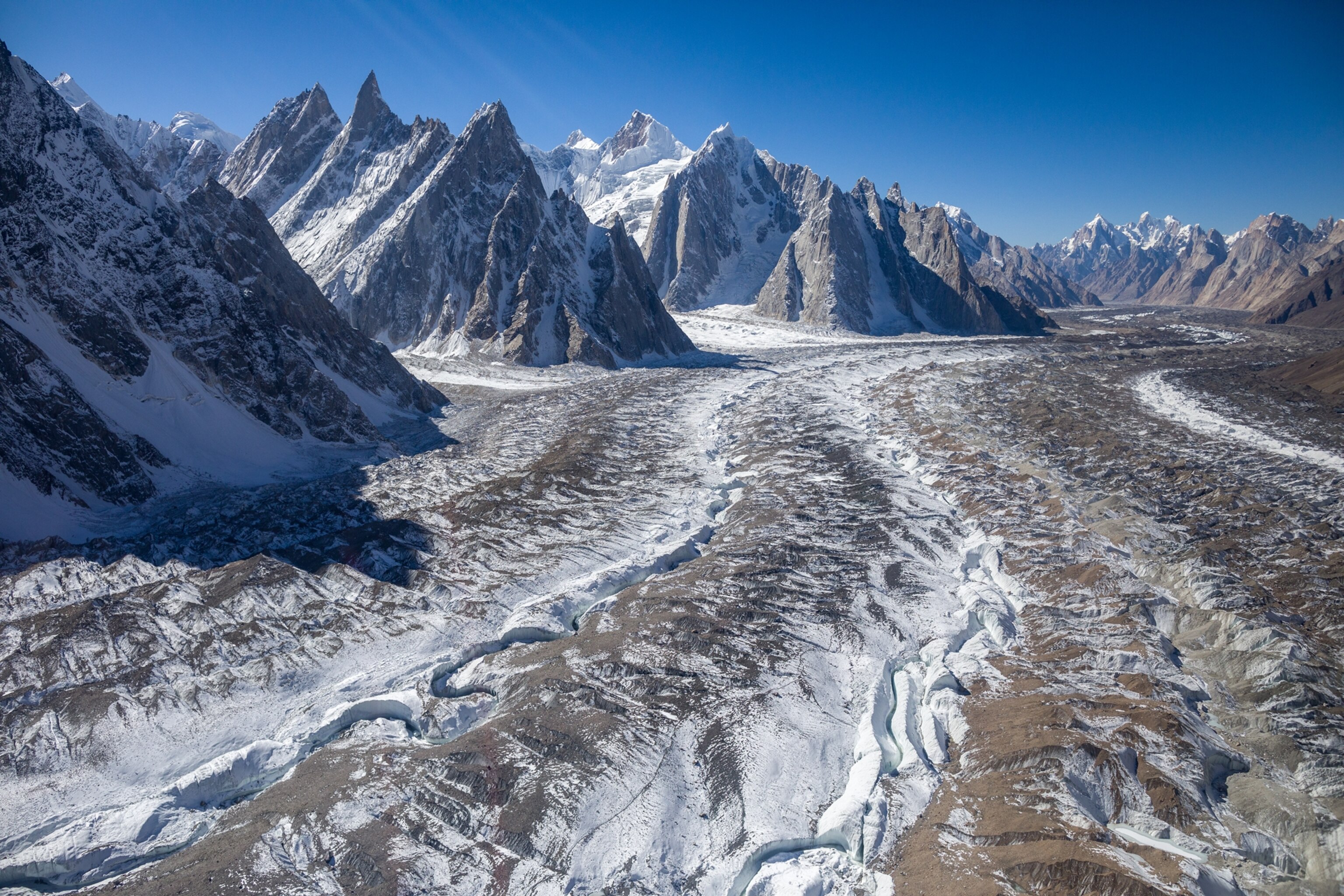
An aerial view of the Concordia area of the Baltoro Sector shows mountains known as K2, Broad Peak, and Masherbrum. The area is a vital tourist locale—and an important part of a supply route for military posts a few miles to the northeast.
After World War II, when the British relinquished control of the Indian subcontinent, they hastily decided to divide the region into two states based on the two dominant religions, India for Hindus and Pakistan for Muslims.
Commissions appointed by the British viceroy, Lord Louis Mountbatten, and made up of representatives from the two most influential political parties, the Indian National Congress and Muslim League, were convened to decide the new boundaries—an impossible task given that millennia of overlapping cultures and empires had left South Asia with intermingled populations of Hindus, Muslims, and Sikhs.
At the stroke of midnight on August 15, 1947, India and Pakistan gained their independence. Violence erupted as millions of frightened people tried to make their way across the new borders to join people of their religion. The conflict was bloodiest in the Punjab—the subcontinent’s agricultural heartland. Overall, as many as two million people were killed in the chaos.
Under the terms of Mountbatten’s plan, a mountain kingdom north of Punjab known officially as the Princely State of Jammu and Kashmir faced its own special dilemma. Although the population was overwhelmingly Muslim, Kashmir was ruled by a Hindu maharaja and was granted the option to determine which country it would join. But weeks after independence, militias of Pashtun tribesmen, with support from the fledgling Pakistan Army, began moving toward the maharaja’s palace in Srinagar to claim Kashmir for Pakistan. The maharaja panicked and signed an Instrument of Accession to India. India responded with a military airlift and stopped the militias. Within weeks the new countries were at war.
When the dust settled, the opposing armies faced off along a hilly cease-fire line that wound through the middle of Kashmir. After a treaty brokered by the United Nations in 1949, teams of military surveyors from India and Pakistan, under UN supervision, set out to determine the cease-fire line. Both sides agreed it would be a placeholder until further negotiations could set a permanent border. But years went by without progress. Then in 1962, Chinese forces seized the Aksai Chin, a high desert region in the eastern corner of Kashmir, which further muddled the border question.
When Weathersby’s airgram arrived in 1968, this was the complicated question Hodgson faced: How should the United States show this flummoxed state of affairs on its maps? If he went by Indian officials’ claims, all of Kashmir legally belonged to India because of the Instrument of Accession the maharaja had signed. If he followed UN Resolution 47, as Pakistan argued, Kashmir was a separate entity, still awaiting a public referendum to decide which country to join. If he reflected the actual situation on the ground, Kashmir was sliced in two, under the de facto jurisdiction of the armies of India and Pakistan, with a small corner controlled by China.

Ropes keep teams safe while traversing some types of terrain. Here soldiers of Pakistan’s 323 Brigade have tied themselves together to lessen the chance one will be lost in an icy abyss as they cross the Gyong Glacier at 17,500 feet. Many crevasses are known by the names of soldiers who have died in their depths.
Throughout the 1960s, Indian diplomats protested how U.S. maps depicted Kashmir as being occupied territory or separate from the rest of India. “The correct position is that the entire State of Jammu and Kashmir is legally an integral part of India, with Pakistan and China in illegal occupation of areas west and north of the ceasefire line,” read a 1966 objection.
After Partition, the U.S. and Pakistan had become Cold War allies, so it might seem that the U.S. would favor Pakistan in such a dispute. But no documents found to date reveal that such political considerations influenced the Office of the Geographer. By 1968 Hodgson had been involved in many sensitive boundary issues. “He had a reputation,” said Bob Smith, whom Hodgson hired to join the office in 1975. “Hodgson could be speaking to the Greeks and telling them in all honesty that their position was untenable, and then tell the Turks the same thing. He told it like it was.”
But there was one other crucial problem with the cease-fire line through Kashmir: It didn’t fully divide India and Pakistan. Instead, at a coordinate point, designated during the demarcation process as NJ9842, the line abruptly stopped nearly 40 miles from the Chinese border. This dead-end line is unique in world geography.
The surveying team had good reason not to continue. Those last 40 miles cut through the rugged heart of the Karakoram. It contained no permanent populations to protect, no known natural resources to exploit, and no easy access to build military infrastructure. Instead of providing a definitive line, the final treaty documents offered only vague guidance for the section beyond NJ9842: “ … thence north to the glaciers.”
In fact, there were many glaciers north of NJ9842. But the largest and most strategically consequential was the Siachen, an immense, winding river of ice that cuts through the eastern Karakoram. “Back then it was something of blank space on the map,” Linthicum says. “The idea that this terrain would be worth fighting over would have struck all parties as absurd in 1949.”
During the fervid summer of 1968, as the U.S. grappled with the Vietnam War and political turmoil at home, Hodgson consulted with other offices inside the State Department to determine how to show the cease-fire line—including the vexing issue of the roughly 40-mile gap.
On September 17, nearly three months after receiving Weathersby’s airgram, Hodgson drafted his response in a letter that remained classified until 2014. “The Department has long recognized the difficulties involved in the production of a map of Indian international boundaries which will not offend the host government and yet not compromise established American positions,” it began.

Soldiers frequent the Ibrahim Sector headquarters near the Gyong La for months at a time, eating canned food and suffering from boredom and lack of exercise. They smoke cigarettes, chew tobacco, and play a board game based on the ancient cross and circle game pachisi .
Then in crisp, authoritative language, Hodgson laid out his guidance for how to show the 1948 cease-fire line on all official U.S. maps. But then he added: “Finally, the cease-fire line should be extended to the Karakorum [sic] Pass so that both states are ‘closed off.’ ”
In a single sentence, Hodgson created a straight line traversing snow-clad mountains and high desert in a northeasterly direction to link NJ9842 to the Karakoram Pass, an ancient Silk Road byway on the Chinese border.
Why Hodgson did this remains unknown. He offered no explanation in the letter, and no notes have been found relating to the decision. But from his office on C Street, he must have seen obvious practical reasons.
In 1963 Pakistan and China had signed a bilateral agreement establishing the southeastern end of their shared Kashmir border at the Karakoram Pass, so many observers assumed that would be the logical end point for an Indian-Pakistani border as well. But since India had nothing to do with that treaty, Linthicum says, “it was invalid.”
Linthicum suspects a mapmaker’s fastidious desire to resolve ambiguity may have played a role. “Some people have the completeness syndrome—or completeness obsession—where you have to fill in the gaps.” If both countries were to be “closed off” by the cease-fire line, as Hodgson wrote, the line would need to reach China to form a complete boundary—and the Karakoram Pass was the most identifiable point on the divide.
Yet Hodgson also seemed to understand that his boundary adjustments would be controversial. In a letter to the CIA, he urged maximum discretion. “We would prefer that the change take place gradually so as to reduce to a minimum possible international complications,” he wrote.
Hodgson’s hope to conceal the policy changes may have been wishful thinking. “After all, he should have considered the obvious,” Linthicum says, “that map after map would soon be published, many released to the public, with precisely the full visual evidence of the text in the new policy.”
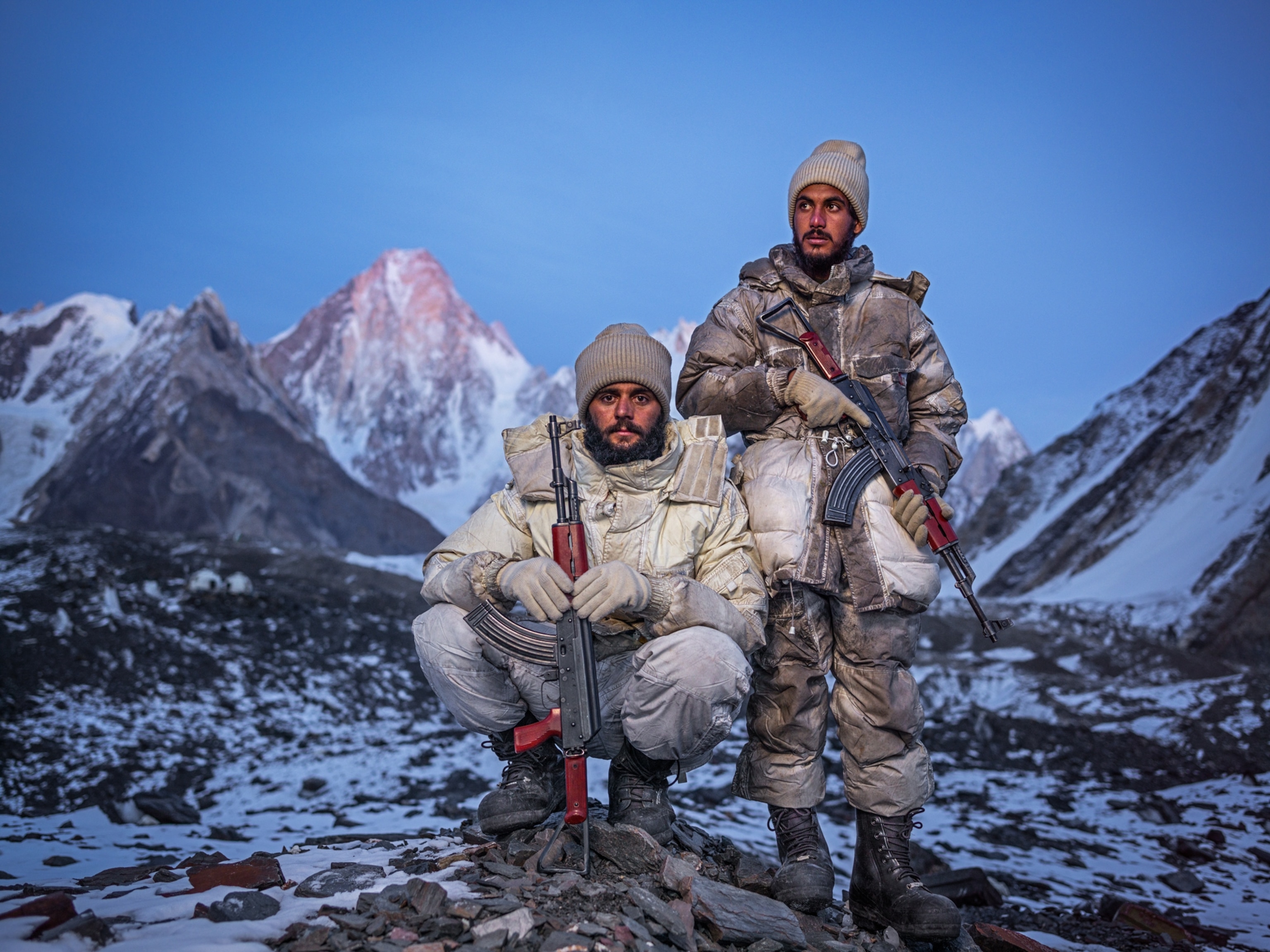
Soldiers serving among some of the world’s most colossal mountains rely solely on each other during rotations. Morale goes up and down in the harsh conditions. Should emergencies arise, medical help is a long way off.
The Mountaineer
I first heard of the Siachen Glacier from a climbing buddy who said it held some of the most desirable unclimbed mountains in the world. “It’s near the border with Pakistan,” he told me. “They won’t let anyone in there to climb.” The summer after my wife and I got married, we traveled to India in search of first ascents in the Nubra Valley, just outside the Indian Army’s militarized zone surrounding the Siachen. We—along with all the other mountaineers who’ve come to this region over the last 40 years—were following in the footsteps of Bull Kumar.
Standing just under five feet six inches tall, with swooping gray eyebrows and a deep, guttural laugh, Narinder “Bull” Kumar, 87, packed numerous adventures into a storied military career. Despite losing four toes to frostbite, Kumar led several ambitious mountaineering expeditions throughout the 1960s and 1970s, including an attempt on Mount Everest. Along the way he rose to the rank of colonel in the Indian Army and became something of a celebrity, meeting Prime Minister Indira Gandhi and forging a friendship with Tenzing Norgay, who, with Edmund Hillary, was first to summit Everest.
Before Kumar died last December, I visited him in New Delhi to hear about his encounter with two German adventurers who approached him in 1977 with a plan to make the first descent of the Nubra River, a chalky deluge that drains from the Siachen. Kumar would later write in his memoirs that when one of the Germans unfolded a map to explain their plan, “I looked at the map and my eyes got stuck.” He asked the German where he got his map and was told it was a U.S. map, used all over the world.
Kumar said nothing but soon recognized the glaring problem: “The line of control, which was then called Cease Fire Line and ended at point NJ9842, had been mischievously or inadvertently or deliberately [altered].”
Thus, Bull Kumar discovered Hodgson’s line.
He took his discovery to Lt. Gen. M.L. Chibber, then India’s director of military operations. Pakistan is occupying thousands of square kilometers of land on its own, he thundered, “and we know nothing!” As supporting evidence, Kumar and Chibber soon learned from the American Alpine Journal that a Japanese mountaineering team, accompanied by a Pakistan Army captain, had visited the upper Siachen two summers before and made the first ascent of Teram Kangri II, a 7,000-meter peak.
Kumar offered to lead a patrol under the guise of a mountaineering expedition to the same peak to gather intelligence. When Kumar’s team returned to civilization, he penned gallant accounts of their climb for the Illustrated Weekly of India and the Himalayan Journal. Curiously, he proclaimed they had accomplished the first ascent of the mountain, despite the 1975 Japanese expedition being well reported.
More Indian patrols followed in the late seventies and early eighties, including to K12, Saltoro Kangri, Sia Kangri, and Apsarasas I. The Indians made it a practice to report their climbs as first ascents regardless of previous summits by Pakistani teams. Meanwhile, Pakistan authorized more than a dozen more foreign mountaineering expeditions to visit the Siachen.
At the time, the Indians’ gamesmanship was noticed by journalist Joydeep Sircar. “We are witnessing possibly the pioneering use of sport as a tool for establishment of territorial rights…” Sircar wrote in a prescient piece published in the 1984 Alpine Journal. Oropolitics, the title of the article, gave the practice a name—mountaineering for political purpose.
In August 1983 the Pakistan Army sent a formal note of protest to its counterparts in India: “Request instruct your troops to withdraw beyond Line of Control south of line joining Point NJ9842, Karakoram Pass NE 7410 immediately. I have instructed my troops to show maximum restraint. But any delay in vacating our territory will create a serious situation.”
The Pakistan Army was now claiming Hodgson’s line as its boundary. By then, the line had been included in dozens of maps printed by numerous agencies, all under the seal of the U.S. government. Such was the quiet influence of the Office of the Geographer that the boundary had spread to commercial publishers. Beginning in 1981, it showed up in the National Geographic Atlas of the World as a tiny dotted line less than an inch long. (National Geographic stopped showing the line beginning with the atlas’s 2020 edition.)
But Robert Hodgson didn’t live to see the mounting tensions over his line. In December 1979—several months after news of Kumar’s expedition was published—Hodgson, who’d been promoted to head the Office of the Geographer, died of a heart attack. He was 56.
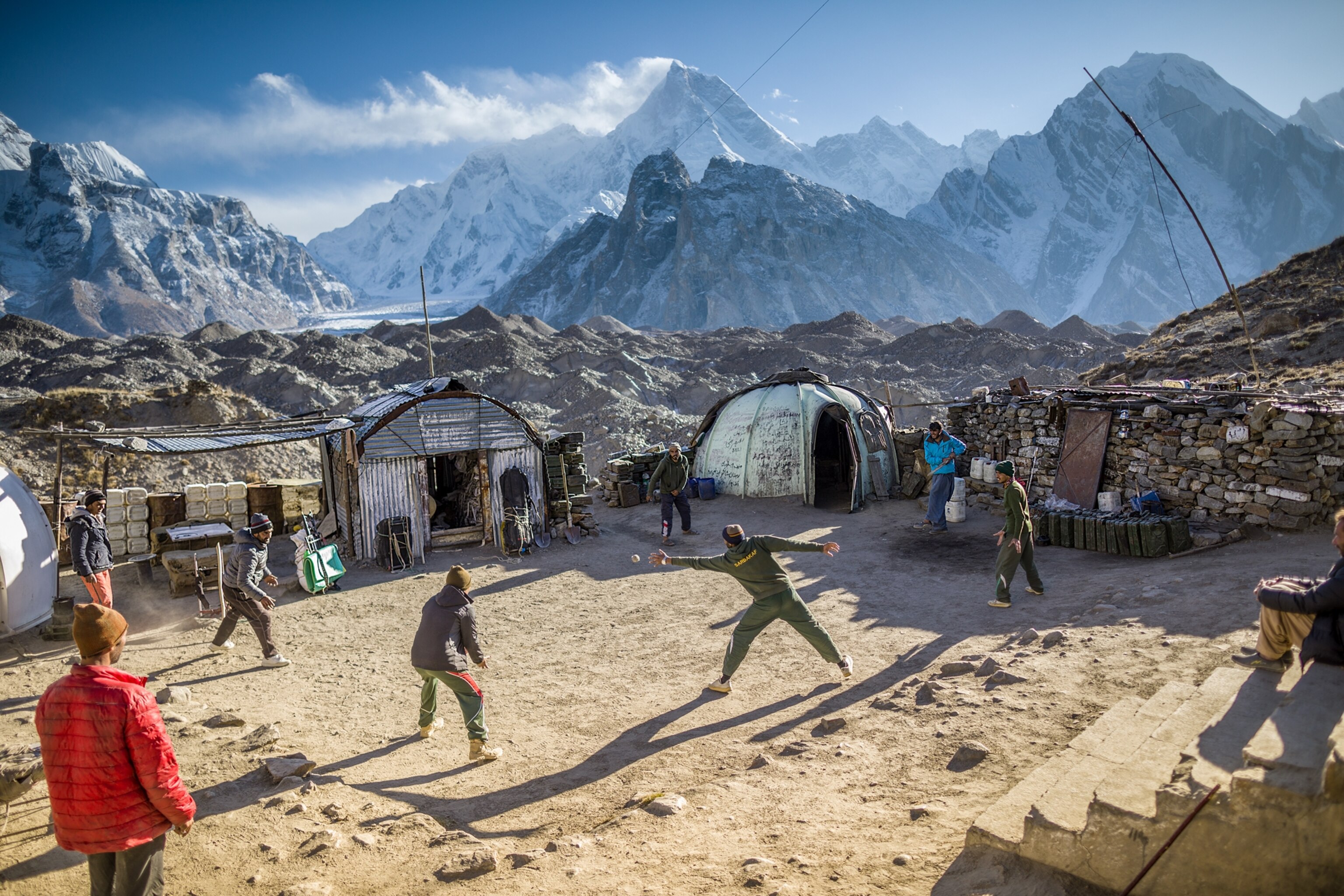
A game of cricket provides a dose of levity and exercise for men of the Pakistan Army’s Punjab Regiment at Gora I, an administrative post at roughly 13,700 feet alongside the Baltoro Glacier. Masherbrum, a 25,659-foot peak and part of a subrange of the Karakoram Range, shimmers in the distance under its blanket of snow and ice.
The Soldier
On April 13, 1984, the Indian Army launched Operation Meghdoot, named after a Sanskrit word meaning “cloud messenger.” Using helicopters, the army inserted a platoon of soldiers to occupy the Bilafond La, one of the mountain passes favored by climbers coming from Pakistan. Soon it occupied two more passes. With these moves, India controlled the Saltoro Range, which would become the front line in the fight over the Siachen Glacier and has shaped the archipelago of military outposts that defines the stalemate today.
Accounts from the front lines of the Siachen conflict often are couched in romantic notions of patriotism, but spending weeks or months at high altitude is far from romantic. At about 18,000 feet above sea level, the human body, starving for oxygen, begins to break down. Given enough time, death is inevitable.
But on the Siachen and surrounding glaciers, the two armies occupy more than a hundred permanent high-altitude posts. To maintain these camps requires an astounding logistical effort—essentially planning more than a hundred mountaineering expeditions simultaneously and maintaining them in perpetuity.
In 2011 Cory Richards camped near one of the Pakistani outposts during a winter expedition to Gasherbrum II. There he found the frozen wreck of a crashed helicopter and a platoon of curious soldiers living in spartan camps. “We had internet, so they would come over and we would have tea,” he says. “They asked if they could use my Facebook.”
It was partly that encounter that had led us to ask the Pakistani government to let us document life on the Siachen front lines. Through the years other journalists have made this trek, and it was clear the Pakistan Army had a practiced script for visitors as we sat for the first of several briefings during our tour of some of its bases.
“In the face of all odds, the Defenders of K2 occupy the highest military positions anywhere in the world,” a captain from the 62 Brigade told us. “This would be a solid point to be included in your story.”
From its headquarters in the town of Skardu, the 62’s supply line snakes up the Braldu Valley to the Conway Saddle, a pass that rises to almost 20,000 feet. The last half of the journey is accessible only by foot or helicopter. The army made us walk so that we could acclimatize.
The trail looks easy on the map—a broad, nearly treeless valley etched by fields of boulders and gushing streams. “For you this is fun, but we do this every day,” one soldier told me on our first morning of walking. By the time we reached a camp known as Paiju, our joints were stiff and our feet tender.

A well-maintained path leads to a rock patio for prayer at the Gora I post. “We never discuss hardships with our families,” one soldier says. “We just say we are happy and enjoying life.”
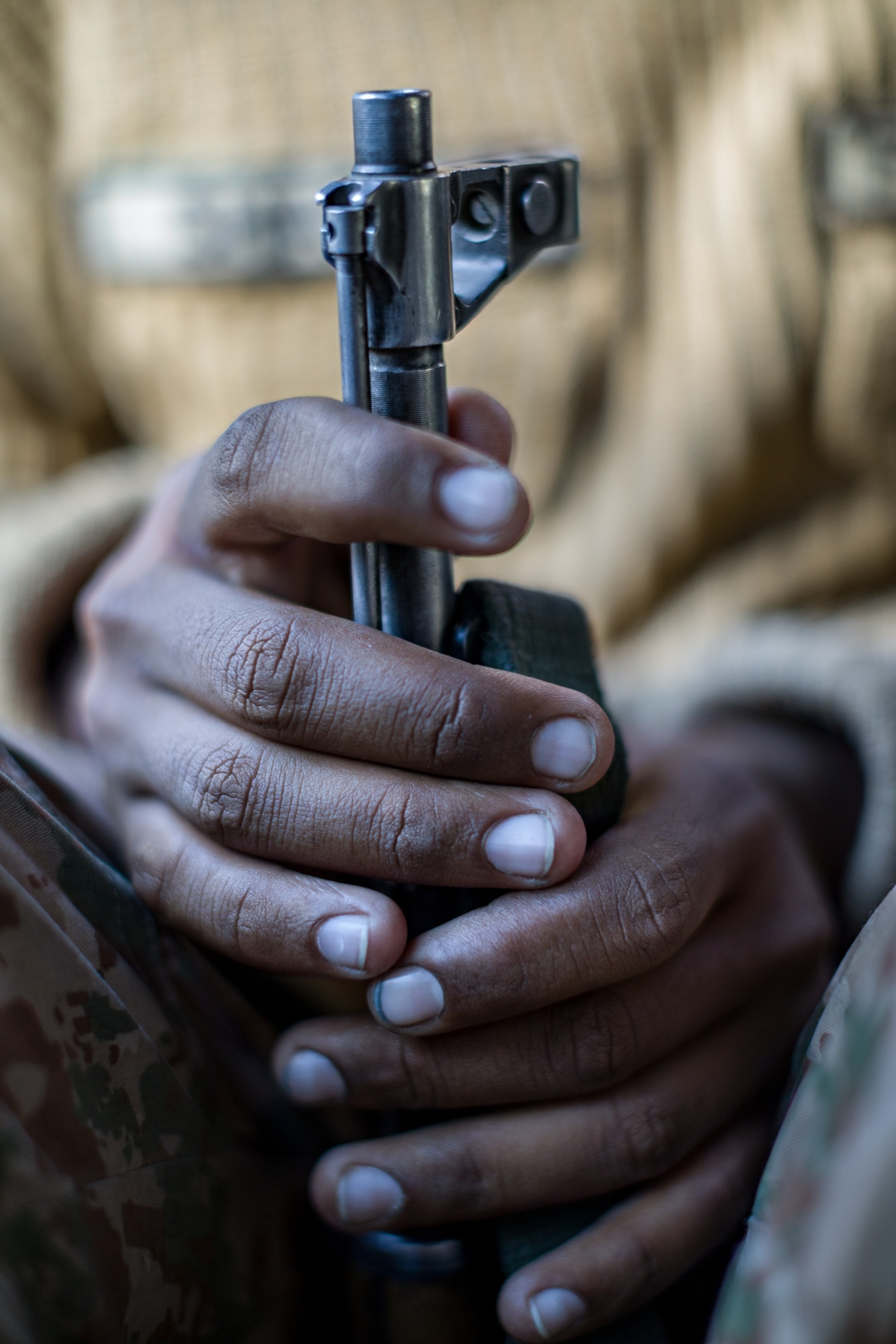
A Pakistani soldier steadies his weapon as he travels in the back of a vehicle en route to Goma.

The living conditions there are relatively comfortable. A generator and some satellite dishes provide an unreliable connection to the outside world. In the officers’ quarters, a tangle of tenuously spliced wires connected to a small TV allows for evening entertainment.
“We use it for watching motivational movies,” one man told us. “Like Rambo?” Cory joked.
Other posts don’t have it so easy. Urdukas, a tiny outpost of three prefabricated Styrofoam igloos set on a spectacular perch at 13,200 feet, is occupied by just four enlisted men. “It’s very boring,” one soldier whispered over roti and sinewy chicken stew. “There’s no mobile, no movies.” During winter, Urdukas receives only four and a half hours of sunlight a day. The camp is surrounded by hundreds of jerry cans holding kerosene—the soldier’s lifeblood, providing cooking fuel and warmth. Inside each shelter, everything is covered with soot. Here the only extravagances are naswar—a coarse variety of chewing tobacco—and ludo—a Pakistani version of pachisi played on homemade game boards. “If there are officers, it’s more comfortable,” one soldier said.
The next day we met a dozen soldiers heading down after a three-week patrol. Their demeanor was festive. I chatted with a friendly captain, a doctor, as he smoked a cigarette.
“It was OK on this patrol,” he said. “We had to evacuate three men for high-altitude cerebral edema, but this is normal.”
Until 2003, the two sides regularly traded artillery barrages and sniper fire, but a cease-fire agreed to that year has left little for soldiers to do other than watch one another and survive the elements. “It’s like a football match,” another captain told me of life on the front line. “Usually we warn by raising a red flag. We warn, ‘Please stop whatever you’re doing. Our guns are ready to fire.’ As an answer, they raise the white flag to say, ‘OK, we’re stopping.’ ” Otherwise, each day is measured in cigarettes and cups of tea, games of volleyball or cricket, prayers and daily chores.
Both India and Pakistan have learned from their 35 years of mountain warfare how to care for their soldiers in this environment. Army doctors identified carbon monoxide poisoning and embolisms as common issues caused by soldiers spending too much time sedentary in snowbound posts. Soldiers now are required to exercise every day. “Every S.O.P. [standard operating procedure] is written in blood,” one colonel said.
Before coming here, many of the soldiers we met had seen combat in Pakistan’s tribal areas bordering Afghanistan, part of the Pakistani government’s effort to confront Islamic terrorism. “We have to fight nature here, and nature is unpredictable,” the doctor said ruefully. “Humans are easier.”
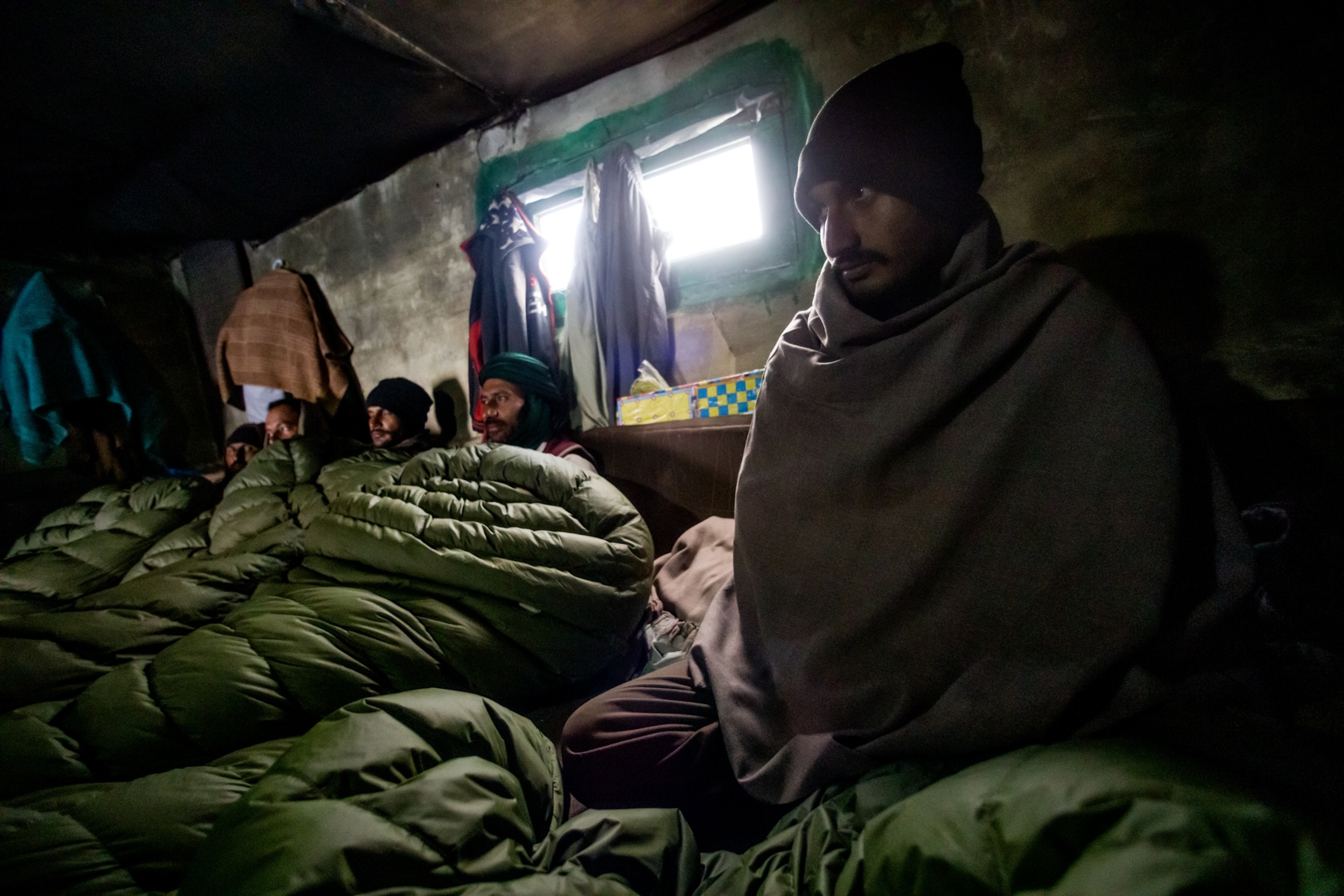
Pakistani soldiers wake up in living quarters at Paiju near the snout of the Baltoro Glacier. Their only sources of heat are kerosene stoves and each other. Winter temperatures fall to minus 70°F.
In the autumn of 1985, more than a year after India had seized the Siachen and 17 years after Hodgson’s line was published, an Indian diplomat sent an official inquiry. It eventually reached the desk of the State Department Geographer at the time, George Demko, who, like Hodgson, was a former marine and had served in Korea.
More than a year later, Demko issued an update to the mapping guidance that stated the Office of the Geographer had reviewed the depiction of the India-Pakistan border on U.S. maps and had found “an inconsistency in the depiction and the categorization of the boundary by the various [map] producing agencies.” To correct this depiction, he wrote, “the Cease-Fire Line will not be extended to the Karakoram pass as has been previous cartographic practice.”
Hodgson’s line had been erased. Although the line was removed from U.S. maps, the Office of the Geographer offered no explanation for why it had appeared on them in the first place.
A few years after Demko’s correction, Robert Wirsing, a scholar at the University of South Carolina who’d been closely following the Siachen conflict, began inquiring about the line that had once appeared on U.S. maps and then disappeared. Wirsing, who’d learned from an Indian general that the Indian government had asked for an explanation to no avail, sent letters to the State Department and the Defense Mapping Agency, asking about its origins.
In 1992 Demko’s successor, William Wood, responded. “It has never been US policy to show a boundary of any type closing the gap between NJ 9842 and the China border,” he wrote. Wirsing did not pursue the matter.
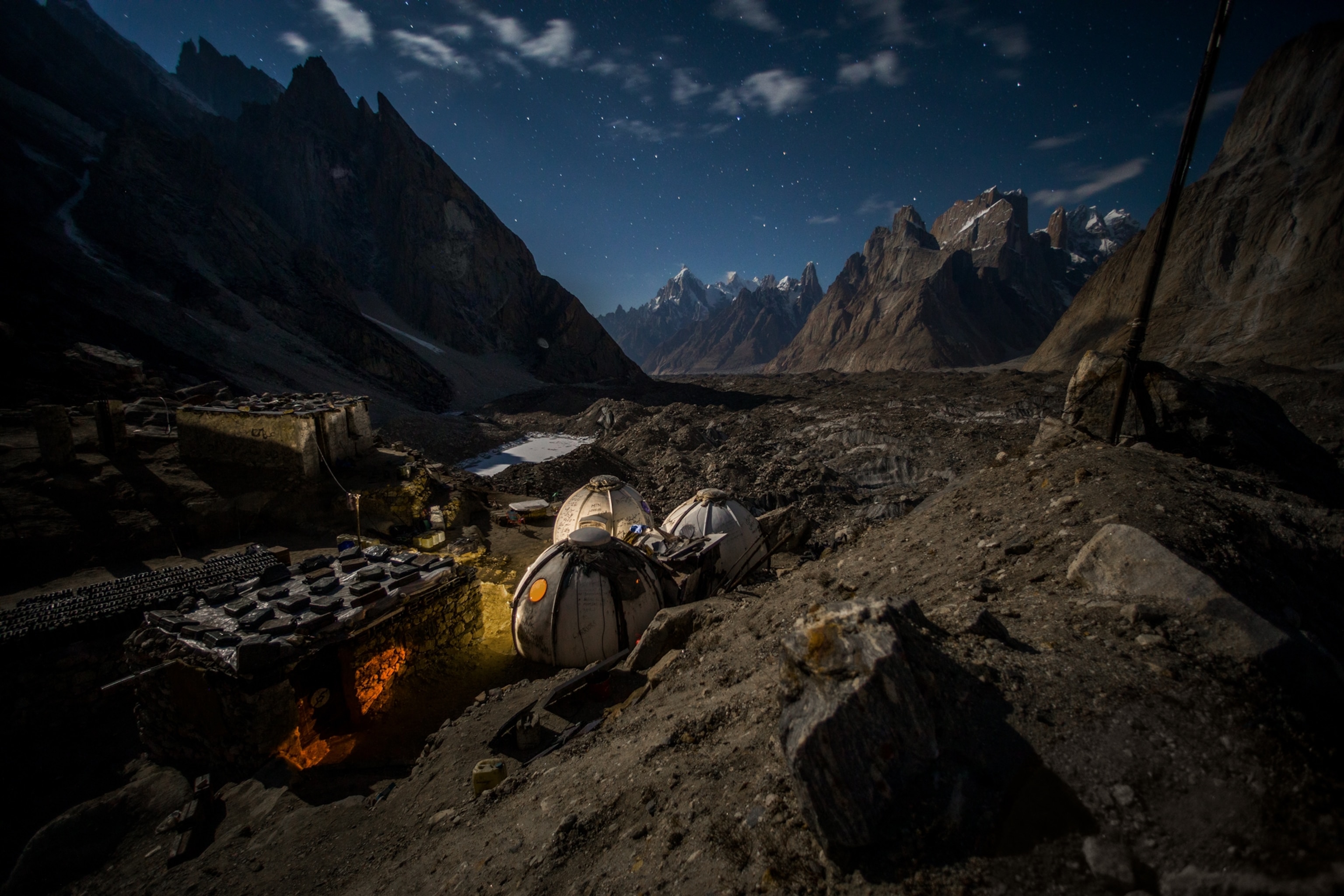
Four enlisted men maintain the post at Urdukas, perched above the Baltoro Glacier at 13,200 feet. Soldiers struggle with boredom, but Pakistan’s army prides itself on discipline. “If they tell us to climb a mountain, it’s ‘Yes sir,’ ” one officer says. Administrative posts lie along logistical supply lines, while observation posts are at or near the front lines, with a view of the enemy.
The Aftermath
Pakistani officials never agreed to take Cory and me to any point near the front line where we might get a glimpse of point NJ9842. I’m not sure exactly what I expected to see that I couldn’t make out from zooming in on Google Earth. It’s just a human-created designation—a lonely spot on a glaciated ridge with an Indian Army encampment nearby.
Instead, the officials offered to show us another spot. We loaded into jeeps and jostled along a dirt track leading up the cavernous Bilafond Valley. Directly above us, brilliant granite summits glistened in the morning sunlight, though the valley floor remained obscured in deep shadows. We stopped at the edge of a large boulder field.
On this spot, just before 2:30 a.m. on April 7, 2012, the Pakistan Army suffered its worst defeat in the Siachen conflict, though one the Indians had no part in. A massive landslide released above a camp serving as a battalion headquarters—the same camp from which Abdul Bilal had planned his assault. Soldiers at an artillery base a mile and a half away reported a loud rumbling noise, excessive snow particles in the air, and a lone dog barking forlornly.
“It was beyond imagination,” Maj. Gen. Saqib Mehmood Malik said. One hundred and forty men housed in a dozen buildings had been buried under more than 100 feet of rock, ice, and snow. It was months before the first body was found.
Cory and I made our way through the still dangerously unstable field of debris. Crude signs fashioned from corrugated roofing marked where the barracks buildings had stood—each painted with the numbers of bodies recovered there.
“It’s a strange feeling, but a matter of extreme pride to come here,” one officer told us. But I was left wondering: Did these people die because of a geographer’s mistake?
Hodgson’s line “definitely played a role in leading to the war. It did not result in the war, but it was most decidedly a factor,” Dave Linthicum says. “The phrase ‘smoking gun’ was used,” he says of the moment he discovered Hodgson’s airgram buried in State Department records. For years Linthicum kept a photo of Robert Hodgson taped above his office workspace, “as a reminder to myself not to f-up,” he says, “and be responsible.”
Wirsing agrees the line played a role in the conflict, but he adds, “I have no reason to think someone deliberately decided to hand this territory to Pakistan.” He also has no reason to believe any peace agreements will be negotiated soon. “I have friends who say [the Siachen Glacier] should be converted into an international peace park,” he says. But recent events, he notes, including continued violence in Kashmir and border tensions between India and China, make a resolution of the issue seem improbable anytime soon.
Wirsing doesn’t necessarily agree with the “two bald men fighting over a comb” analogy. “ ‘Irrational’ is a word I encountered so often in scholarly discussions and writing about Indian-Pakistani relations,” he says. “I do not attribute much that happens between India and Pakistan to their emotions … I believe they’re there for pretty good reasons, even strategic reasons … given the fragility of boundaries in that area.”
I was born eight days before Robert Hodgson died in 1979, and as I followed his trail through State Department archives, this coincidence made me feel oddly connected to him. I often found myself staring at the only photo I could find—a black and white headshot included with his obituary in a State Department newsletter. It depicts a middle-aged man with receding hair, a hint of dark circles under his eyes, and a Mona Lisa-like expression, not quite smiling, giving nothing away.
I tried imagining him during that hothouse summer of 1968, poring over Himalayan maps in his State Department office as civil rights and antiwar protests boiled around the country and Cold War politics seethed around the world. I wanted to learn more about this ghostly bureaucrat who stood at the center of this mystery. But other than his colleague Bob Smith, I couldn’t find anyone who’d known him. And as the print deadline for this story came late last year, it seemed Hodgson’s legacy would remain that of a gray man defined by the enigmatic argot of official documents.
That changed one morning in February, 2021 when I finally tracked down the phone number for one of Hodgson’s daughters, Amy Wilcox. I explained the story of the line her father had drawn on a map. The voice on the phone was hesitant at first. She had never heard of the Siachen conflict. She told me she’d been a teenager when her father died and didn’t really know much about his work, other than once he’d been part of a delegation sent to Cuba and the family had caught a glimpse of him on the TV news.
Over the next couple weeks, I exchanged phone calls and emails with her and two of her sisters. The portrait they offered of their father led me to view Hodgson as something of a victim of geography himself.
When he was 21, Hodgson, a second lieutenant serving in the 6th Marine Division, was sent to Okinawa. U.S. strategists had identified the island as a critical jumping off point for an invasion of the Japanese mainland.
And Hodgson, who had been married for less than six months, arrived on the island in April 1945 where he faced some of the bloodiest fighting of World War II. As his unit converged on the island’s largest city, Naha, Hodgson was nearly killed in an artillery barrage on May 27, 1945, sustaining shrapnel wounds to his chest, neck, and leg that kept him in hospitals for months.
His oldest daughter, Susan Hodgson Sommerfeld, dug up some old medical records for me, including one military doctor’s report noting that a piece of shrapnel had remained in his ribcage that couldn’t be safely removed.
He never spoke about the war to his children, who learned about his experiences from their mother. “We weren’t even allowed to watch war movies growing up,” Amy recalls. “One time we were watching The Bridge on the River Kwai and Mom ran in all in a panic,” she says, noting her mother was sensitive to anything that might trigger her husband’s memories.
But the children didn’t view him as a haunted veteran. “He was funny,” says Amy. “I always characterize him as the absent-minded professor,” his daughter Laura Johanson remembers. He unfailingly had a book in his hand as he rushed out the door of their home in suburban Virginia to catch the bus each day, but his suit jacket might not match his pants. Occasionally someone from work would call to give his wife, Margaret, a heads up, Laura says, “‘He’s meeting with Kissinger today—make sure he matches.’”
By the late 1970s, his heart was faltering, but when doctors attempted bypass surgery, the damage from his war injuries prevented the procedure. In 1979, he was invited to a United Nations conference in Mexico City. The city sits at more than 7,000 feet above sea level and Margaret was concerned about how his heart would handle the thin air, so she accompanied him. It was prescient. During the conference, he suffered the heart attack that would lead to his death at age 56.
Afterward, the geographic community acknowledged many of his contributions, particularly his work on the US-Cuban maritime boundary, which resolved a difficult point of contention between the two countries. A seamount in the Atlantic was named in his honor.
Now, his legacy will also include the story of Hodgson’s line, a fact I believe would not sit well with a man who carried both the physical and psychic scars of warfare and understood so well the importance of the lines on maps.
But as long as humans endeavor to divide up our planet into neat polygons, some of those lines are destined to be disputed, and men like Robert Hodgson, Abdul Bilal, and Bull Kumar will be sent to fight over them. Geography dictates its own terms.

How a tiny line on a map led to conflict in the Himalaya
The untold story of a U.S. geographer’s error that pushed India and Pakistan to fight on the world's highest battlefield
Last edited:




